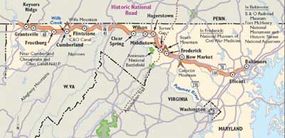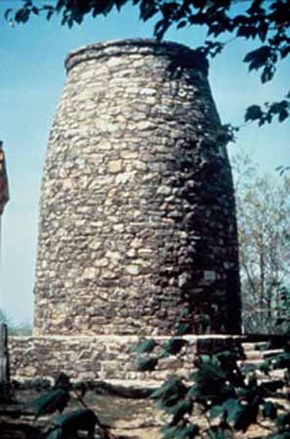Maryland is home to 170 miles of the Historic National Road. Along the way, visitors can hike, bike or picnic in state parks and forests. They can also stop at countless museums, attractions, restaurants and lodging sites, some of which existed in the road's earliest days.
Many layers of urbanization have modified this historic route, but the diligent traveler still may follow the old Historic National Pike through the streets of Baltimore westward into the historic Maryland countryside. Today, with the construction of new roads, many historic towns and sites originally connected to the Historic National Pike lure modern travelers with rugged charm, including a host of antique shops, specialty shops, and unique restaurants.
Advertisement
Cultural Qualities of Historic National Road
As the first federally funded road, this byway blazed a trail for the emerging nation to follow. Maryland's Baltimore to Cumberland section of the Historic National Road was designated the Historic National Pike. Towns and cities along the pike began to spring up to provide comforts for weary travelers heading west. Modern travelers of the Historic National Pike will find communities proud of their vibrant heritage. With Interstate 70 bypassing many of the original Historic National Pike cities, they have developed into artistic communities with a passion for diversity.
Historical Qualities of Historic National Road
In the late 18th century, as the population of the United States began to grow, President Thomas Jefferson encouraged the development of a transportation infrastructure that would connect the Eastern Seaboard with points farther inland. The construction of the National Road westward from Cumberland was the first such investment by the federal government.

Natural Qualities of Historic National Road
From the shores of the Chesapeake Bay to the majestic Negro Mountain, the Historic National Road offers many natural wonders. Many state parks along the byway offer quiet breaks in the long drive. As the byway continues into western Maryland, it passes through many mountain peaks. Before the byway continues into Pennsylvania, it journeys through the city of Cumberland, which is nestled in a small mountain valley. Here, mountains tower 1,000 feet around the city.
The most magnificent feature to note in the byway is the Narrows, located northwest of Cumberland. The Narrows is an unusual geologic formation near Cumberland that provides a pass through the Allegheny Mountains. Wills Creek runs north and south through the Narrows, creating the narrow gorge through Wills Mountain.
Qualities of Historic National Road
Perhaps the most popular destination in all of Maryland is Baltimore's Inner Harbor, where you'll find outdoor performances, numerous eateries, the Baltimore National Aquarium and Marine Mammal Pavilion, the Maryland Science Center and Davis Planetarium, the Pier 6 Concert Pavilion, historic ships, Harborplace shops, and much more.
If you love outdoor activity, this byway features fantastic biking, boating, hiking, and rock climbing. You can find numerous places to fish as well as hunt deer, turkey, grouse, squirrel, rabbit, quail, and waterfowl. If you like to view animals but not necessarily hunt them, you can also find excellent bird-watching areas.
Find more useful information related to Maryland's Historic National Road:
- Maryland Scenic Drives: Historic National Road is just one of the scenic byways in Maryland. Check out the others.
- How to Drive Economically: Fuel economy is a major concern when you're on a driving trip. Learn how to get better gas mileage.
Advertisement

